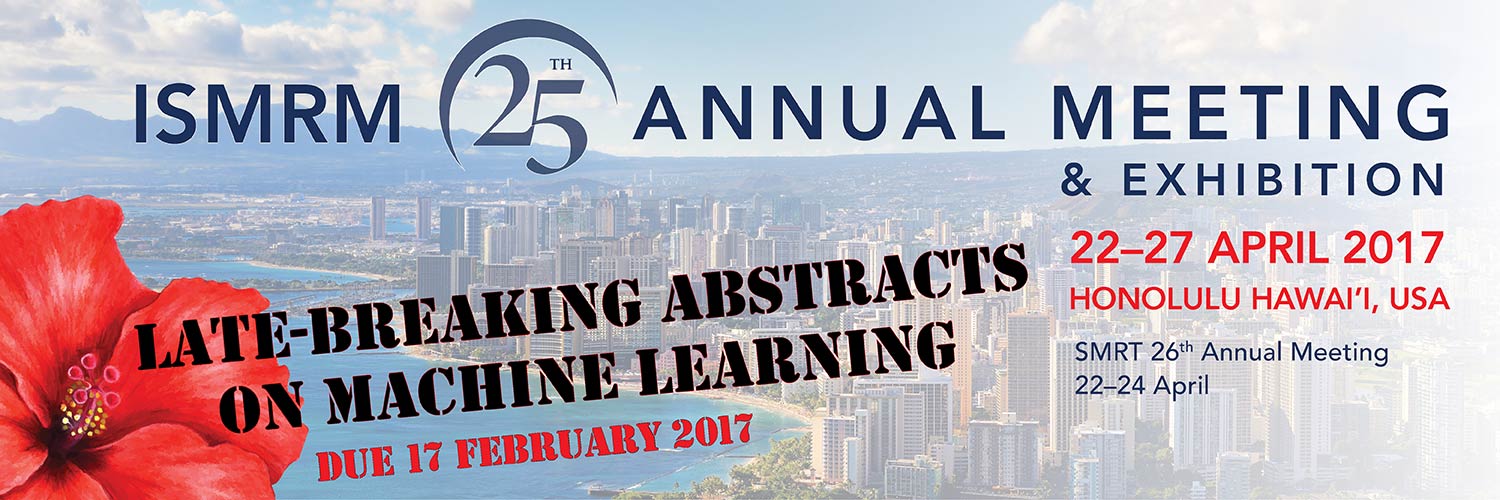
Abstract Submission Site Opens: 27 January 2017
Abstract Submission Deadline: 17 February 2017, 23:59 US EST
Submitters will be notified by 08 March 2017 whether their abstracts have been accepted.
Note: No stipends are available for this program.
Call for Late-Breaking Abstracts
The Annual Meeting Program Committee is very excited to announce a new feature at this year’s ISMRM Annual Meeting: a late breaking session! The topic for this year’s late breaking session is “Machine Learning.”
Due to the fast progress in this area and the broad applicability across the field of MRI, we will offer research groups the opportunity to share their latest results at the Annual Meeting in Honolulu.
Abstract will need to be uploaded to the abstract submission site, following the same format and guidelines as the abstracts submitted in November. Please note that late-breaking abstracts must be new submissions, and not duplicates of work previously submitted to the society.
Start preparing your abstract and look for the abstract submission site to open next week. We look forward to seeing your latest results!
– Scott Reeder, M.D., Ph.D., ISMRM 2017 Annual Meeting Chair
SUGGESTED ISMRM abstract format:
(Please note this is only a guideline, understanding that some abstracts may not necessarily lend themselves to this format): Include within your abstract the following sections. In each section, answer the question listed below. (Do not repeat the actual question in the body of your abstract.)
- INTRODUCTION: “Why was this study/research performed? What unsolved problem are you addressing?”
- METHODS: “How did you study this problem?”
- RESULTS: “Report the data and statistical analyses”
- DISCUSSION: “How do you interpret the the data?”
- CONCLUSION: “What is the relevance to clinical practice or future research?”
- REFERENCES: References should use the suggested style below.
WORD LIMITS
The following word limits will apply:
- 100 words for the synopsis
- 750 words for the body of the abstract (references not included)
- Up to 5 figures
- 100 words per figure captions
CITATIONS IN THE BODY OF THE PAPER
Cite each source in numerical order using superscript Arabic numerals (1, 2, 3…).
- Example 1: A review of regulations has been complete by the WHO.15
- Example 2: The data were as follows 3,4:
- Example 3: As previously reported, 11-14,25
CITATIONS IN THE REFERENCE LIST
At the end of the document, list references numerically in the order by which they were cited in the text.
- Example 1: 1. Rainier S, Thomas D, Tokarz D, et al. Myofibrillogenesis regulator 1 gene mutations cause paroxysmal dystonic choreoathetosis. Arch Neurol. 2004;61(7):1025‐1029.
- Example 2: 2. World Health Organization. Injury: A Leading Cause of the Global Burden of Disease, 2000. Geneva, Switzerland: World Health Organization; 2002.
- Example 3: 3. Weiss R. The promise of precision prescriptions. Washington Post. June 24, 2000:A1. http://www.washingtonpost.com. Accessed October 10, 2001.
General Content Guidelines
- The content may not promote the proprietary interests of any commercial entity. Evident bias in favor of a particular product or company is grounds for rejection.
- Content must be restricted to scientific, engineering and clinical studies, as well as, industry issues and operation of devices. Product /company names should be included only to identify the MR hardware/software/ peripherals used, but not to promote proprietary interests (see Point 1)
- All recommendations involving clinical medicine must be based on evidence that is accepted within the profession of medicine as adequate justification for the recommendations as indications or contraindications in the care of patients.
- All scientific research referred to, reported or used in support or justification of a patient care recommendation must conform to generally accepted standards of experimental design, data collection and analysis.
- Abstracts previously submitted, accepted and published to other societies, journals or ISMRM programs should NOT be submitted to this meeting.
- Abstracts previously submitted to the ISMRM or to another society/journal, but not accepted, may be resubmitted.
- While duplicate material is not permitted, closely related/similar material is acceptable.
